Installing a ventilation fungus on the roof: types and methods of installing a deflector on an exhaust pipe
When thinking about the ventilation system in your home, you most likely wondered how much it is necessary to install a ventilation fungus on the roof, and if there is such a need, then which fungus should you choose?
In fact, the fungus, or as it is also called the deflector or ventilation cap, performs several very important functions. Its absence, as well as the wrong choice, can lead to cessation of draft and damage to ventilation equipment.
We will help you understand the useful functions that the device performs. Let's tell you what kind of ventilation fungi there are. We will advise you on how to make the right choice.
The content of the article:
Purpose and types of ventilation fungi
If the pipe leading above the roof is not equipped with any fungus, then it can effectively remove air from the room only in complete calm.
Even the slightest rain will disrupt the draft or cause the air flow to flow in the opposite direction. In addition, dust, snow, fallen leaves raised by the wind, branches and other objects that can damage the ventilation system will get into the open pipe.
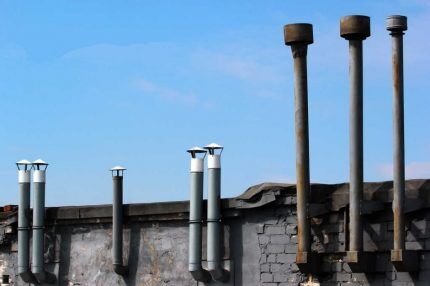
To eliminate such phenomena, a ventilation hood is installed on the ventilation pipe, which performs three functions:
- Protects ventilation pipe from ingress of precipitation and foreign objects;
- Does not allow the wind to stop or direct the air flow in the ventilation duct in the opposite direction;
- Increases traction in windy conditions.
There are several types of fungi that have their own advantages and disadvantages, but at least one of them must be installed. The simplest design installed on a ventilation pipe is a deflector umbrella.
It has sufficient functionality, is able to increase traction and protect the pipe only from precipitation getting into it. It is used mainly in areas with medium and high wind loads. There is no need for additional tricks to increase the draft in the exhaust pipe.
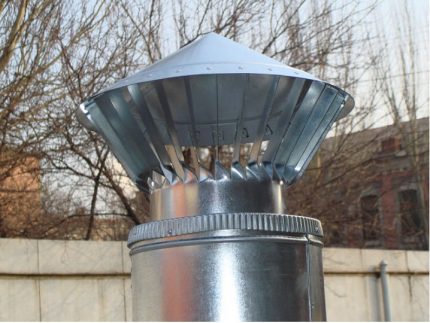
The ventilation umbrella has become widespread due to its low price and the possibility of self-production from scrap materials. However, it is undesirable for use in ventilation systems, especially natural ones, since it practically does not prevent the occurrence of reverse draft.
More complex and effective varieties ventilation fungus They differ from an umbrella by the presence of additional parts, such as a diffuser, rings and blades. The most widely used are TsAGI and Volpert deflectors, turbo deflectors, weather vanes, and similar products..
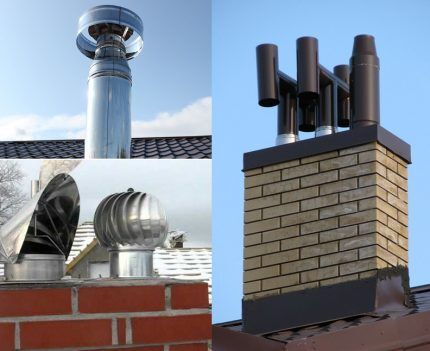
Regardless of the design, all deflectors are united by the ability to increase ventilation draft during windy conditions. This property is given to them by the specific shape of the parts, bending around which the wind creates areas of high pressure and rarefaction.
It is in the region of rarefaction that air rushes from the ventilation duct, while the speed of its movement increases, and the thrust increases accordingly. Most deflectors are energetically passive devices and do not require connection to a power supply.
In addition to their advantages, deflectors have several disadvantages:
- In calm weather, they reduce draft, preventing the free exit of air;
- In cold weather, parts of the device may become covered with frost, narrowing the air outlet openings;
- Turbo deflector and weathervane umbrellas provide less protection from rain, and their rotating parts require periodic maintenance and cleaning.
Despite the listed disadvantages, it is necessary to install a ventilation hood on the exhaust pipe. The deflector model is selected based on the standard wind load in the area.
In places with low wind activity, in settlements surrounded by forest, it is better to equip the mouth of the hood with a turbine deflector.
Making and installing an umbrella
You can make the simplest fungus for ventilation with your own hands. To do this, you will need a galvanized or stainless steel sheet with a thickness of 0.3-0.5 mm.
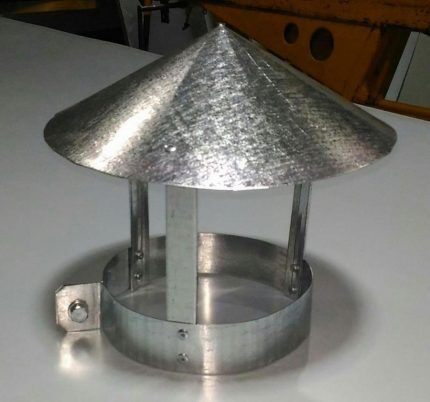
The tool you will need:
- Metal scissors or grinder;
- Hammer;
- Riveter with rivets;
- Drill or screwdriver with drill bit;
- HB gloves.
To fix the clamp on the pipe, you will need an M8 bolt with a nut. Instead of rivets during assembly, you can use metal screws, but they will have to be screwed into the clamp from the inside so that they do not interfere with installation on the ventilation pipe in the future.
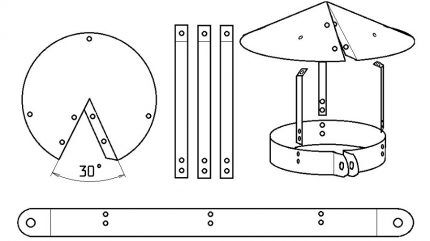
The manufacturing process is not complicated and does not require special skills:
- First, on a sheet of metal with a permanent marker we mark the future parts: a clamp for mounting on a pipe, three legs for fastening and an umbrella-cap. We cut them out with metal scissors;
- In the clamp along the edges we drill holes for the coupling bolt. We give the clamp the shape of a circle, and bend the ears with the holes at an angle of 90 degrees, insert the bolt, and fix it with a nut;
- We drill three pairs of holes in the clamp according to the size of the rivets for attaching the legs at intervals of 120 degrees. In each leg for attaching the umbrella, we drill three holes: two on one side for connection with the clamp and one on the other for connection with the umbrella. We fasten the legs to the clamp with rivets;
- We roll the umbrella-cap into a cone shape. We drill several holes in the overlap area and connect the edges of the umbrella with rivets. At intervals of 120 degrees, we drill three holes along the edge of the umbrella and connect them with rivets to the clamp tabs. The umbrella is ready.
You can make such an umbrella for ventilation pipes from any material and any size.To install the umbrella, you need to put it on the head of the pipe with a clamp and tighten it with a clamping screw and nut.
To give the umbrella cap additional aesthetics and protection against corrosion, it can be painted to match the color of the ventilation pipe or roof. Any metal paint for outdoor use is suitable for this, since the ventilation hood is not exposed to high temperatures.
If you decide to install a factory-made umbrella, then you need to choose a product that is suitable for your ventilation pipe in size and connection method.
Selection and installation of an exhaust deflector
Unlike an umbrella, making a beautiful and flawlessly functioning turbine deflector on your own is quite difficult. Although, if you have enough patience for cutting and riveting metal with a set of tools and a proven blade pattern, this is quite possible.
If you don’t want to deal with precise cutting, then kits for assembling a turbine deflector are actively offered on Chinese trading sites. The customer of such a kit will simply need to assemble everything according to the instructions and put rivets on each blade.
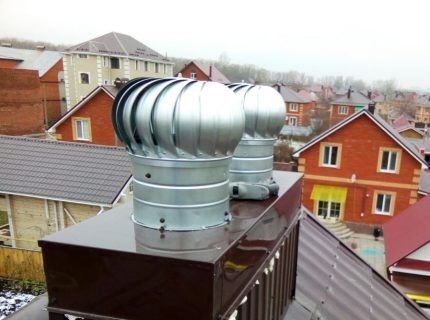
To choose the right deflector, two main factors must be taken into account:
- Diameter and design compatible with yours ventilation pipe;
- Compliance of the deflector with the climatic conditions of the area in which it will work.
The first indicator guarantees you a tight and reliable fastening of the ventilation hood at the exhaust outlet.
Due to the large airflow area, the deflector experiences strong wind loads, so it must be securely fastened during installation. Also, the connection between the ventilation pipe and the deflector should not have any leaks that could cause the ventilation hood to move.

Climatic conditions are also very important. If winds often blow in the area where you live, then there is no need to install turbine deflectors and caps in the form of weather vanes on the hood. They are needed where increased draft is required in all possible ways.
However, they will not be able to work effectively in areas with frequent snowfalls and temperature fluctuations near zero degrees, as they will be covered with an ice crust, lose mobility and will not be able to adapt to the direction of the wind flow.
The TsAGI and Volpert deflectors, although less effective in creating traction in windy conditions, do not contain rotating parts that are susceptible to icing. Such deflectors do not require maintenance and are less expensive.
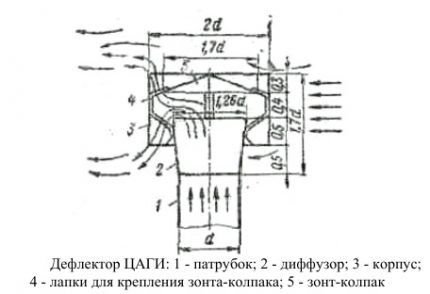
If you have chosen the right deflector for your ventilation pipe, then its installation will not cause any difficulties. Deflectors are attached to the ventilation pipe, usually with clamps or self-tapping screws.

When choosing a deflector with a complex design to make a ventilation fungus, make sure that you have the opportunity to conveniently service it on the roof. After all, even the simplest fungus may require periodic cleaning of frost or lubrication of rotating parts.
Application of ready-made ventilation outlets
If you have no desire to understand the intricacies of the operation of ventilation hoods and the attractive appearance of the ventilation fungus on your roof is important to you, then you should consider installing a ready-made ventilation outlet.

Such outlets are manufactured in the factory and are complete sets of ventilation fungi ready for installation.
This output includes:
- A pass-through unit that ensures a tight connection with any roof;
- Insulated ventilation outlet rising above the roof;
- Deflector providing protection and improving traction;
- Template for easy installation.
Installing a ventilation outlet is not difficult even for beginners.
In the right place, a hole is cut in the roof, onto which a passage unit is installed on top of the sealant and self-tapping screws. Next, an insulated outlet with a deflector is attached to the passage unit.Finally, the outlet under the roof is connected to the exhaust pipe of the internal ventilation system.
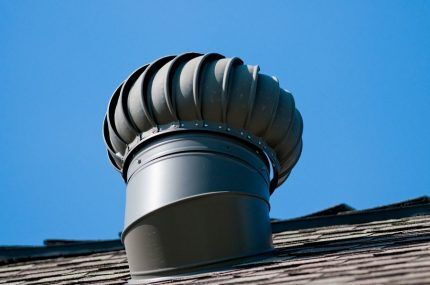
The use of a ready-made ventilation outlet will simplify your choice and allow you to correctly make the ventilation fungus for the hood even with your own hands.
Will familiarize you with the nuances and instructions for making a deflector for a chimney next article, the information of which can also be taken as a basis for those who decide to make a fungus for the hood with their own hands.
Conclusions and useful video on the topic
The video shows the difference in draft in ventilation pipes with and without a weather vane deflector:
The following video will introduce you to the operating principles and design of various deflectors:
This video shows the process of making a deflector:
The right choice, along with proper installation of the ventilation fungus deflector, is important for creating stable draft in the air exchange system. In addition, any of the ventilation hoods prevents precipitation, dust and foreign objects from entering the system channels.
The simplest Grigorovich deflector fungus can be made independently in the shape of an umbrella. If you want to ensure stable draft both in calm and windy weather, then install a deflector on the ventilation pipe, or buy a ready-made factory-made ventilation fungus.
Tell us about how you assembled and/or installed a hood on the ventilation exhaust pipe with your own hands.Share the technological details and models of ventilation hoods known only to you. Please leave comments in the block form below, post photos related to the topic of the article, and ask questions.



